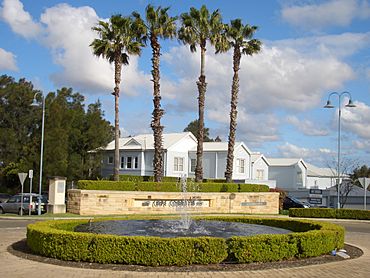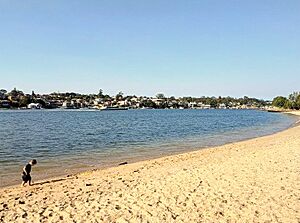Cabarita, New South Wales facts for kids
Quick facts for kids CabaritaSydney, New South Wales |
|||||||||||||||
|---|---|---|---|---|---|---|---|---|---|---|---|---|---|---|---|

Cape Cabarita
|
|||||||||||||||
| Population | 1,957 (2016 census) | ||||||||||||||
| Postcode(s) | 2137 | ||||||||||||||
| Elevation | 16 m (52 ft) | ||||||||||||||
| Location | 16 km (10 mi) west of Sydney CBD | ||||||||||||||
| LGA(s) | City of Canada Bay | ||||||||||||||
| State electorate(s) | Drummoyne | ||||||||||||||
| Federal Division(s) | Reid | ||||||||||||||
|
|||||||||||||||
Cabarita is a lovely bayside suburb in Sydney, Australia. It's located in the Inner West part of Sydney, about 16 kilometres west of the city centre. This area is part of the City of Canada Bay.
Contents
Exploring Cabarita's Location
Cabarita is a beautiful suburb right on the Parramatta River. It's north of another suburb called Concord.
Cabarita Beach and Park
In 2015, Cabarita Beach opened for swimming. The water was finally clean and safe after 70 years! This 200-metre long beach is inside Cabarita Park. It's one of the closest swimming beaches for many people in western Sydney.
Cabarita Park is a great place to visit. It has a shaded playground for kids. There's also a large conservatory and a toddler pool. You can find a kiosk for snacks and drinks. Plus, there are barbecue spots. The park also has hilly areas with amazing views of the water.
Cabarita's Past: A Quick Look
The name "Cabarita" comes from an Aboriginal word. It means by the water.
Early Days and Public Land
In 1795, David Anderson, a soldier, was given land here. Later, in 1856, a part of Cabarita Point was set aside for everyone to enjoy. This public area grew in 1880. Another 9.7 hectares, known as Correy's Garden, were added.
A special building called a pavilion was moved to Cabarita Park. This was the same pavilion where Governor-General Lord Hopetoun announced the Federation of Australia in 1901. That big event happened in Centennial Park first.
Changes Over Time
In the past, Cabarita had swamps and many factories. Over time, new homes were built. These replaced the old factories and filled in the swampy areas.
Until 1948, an electric tramway ran through Cabarita. It went down Cabarita Road. This tram connected the suburb to places like Burwood, Enfield, and Ashfield. The tram line met other lines near Mortlake Street.
Important Historic Sites
Cabarita has some places that are important to its history. These are called heritage-listed sites.
- Cabarita Road: Federation Pavilion, Cabarita Park
Who Lives in Cabarita?
Let's look at the people who live in Cabarita. The 2016 census counted 1,957 people here.
- Most people (65.0%) were born in Australia.
- The next biggest group (5.6%) was born in China.
- Most homes (66.0%) spoke only English.
- Other languages spoken included Italian (5.9%) and Cantonese (5.3%).
- For religion, the most common choices were Catholic (38.3%), No Religion (20.1%), and Anglican (12.6%).
Getting Around Cabarita
You can get to Cabarita by ferry! The Cabarita ferry wharf is where you can catch Parramatta River ferry services. These ferries travel along the Parramatta River.
Homes and Fun in Cabarita
Cabarita and the nearby suburb of Breakfast Point have many new homes. These are often built right along the waterfront. Some of these new areas are called Cape Cabarita and Edgewood.
These housing areas often have lots of fun things to do. You might find playing fields, gyms, and even golf courses. Some also have restaurants. Prince Edward Park is a lovely park located next to Cape Cabarita.
Images for kids










